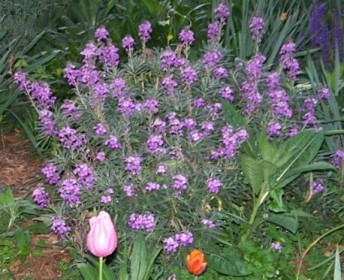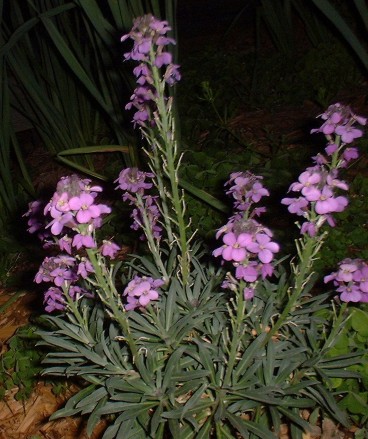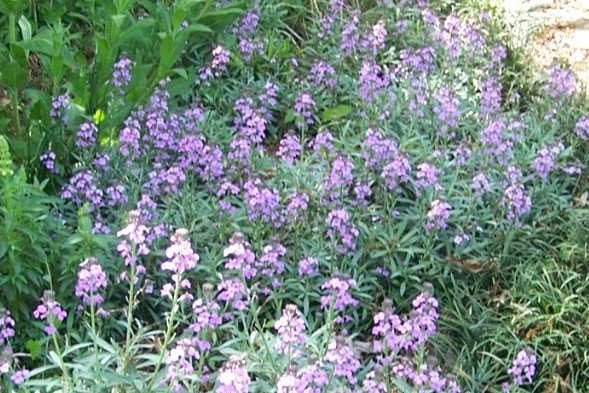 If you have a dry,
fast-draining area against the house or a fence, a dry rock garden, or a
roadside area that needs a little color, by all means try Wallflower this
year for a pleasant surprise.
If you have a dry,
fast-draining area against the house or a fence, a dry rock garden, or a
roadside area that needs a little color, by all means try Wallflower this
year for a pleasant surprise.
The name Wallflower is derived from this plant's traditional use as a plant that
can be tucked into cracks and crevices in rock and mortar walls. Wallflowers are
native to rocky cliffs of southeastern Europe. Their origins and traditional
uses give us a clues as to how carefree the plant is once established in a
suitable place in the garden. Wallflower is not picky about soil at all,
other than it must be totally well-drained. It will not tolerate any
standing water even for a short time and it demands full sun. The plant
grows to the size of a small shrub (1-2 feet high and wide) and blooms pretty
much continuously from spring to fall, though it may slow down some in the
hottest part of the summer. It forms an attractive grey-green mound of
grass-like foliage with flowers borne well above the mound on strong stems that
make good additions to cut flower arrangements.
From a home garden perspective, there are basically two types of wall flower,
Siberian and English. The Siberian types have flowers that are always
orange or yellow-orange, with the English types having purples, whites and pinks
as in the picture above. Both make nice garden plants.
 Wallflowers are generally thought of as biennials or short-lived perennials,
because they burn themselves out after 2-3 seasons, which is a real shame.
Never fear though, because you can propagate this plant fairly easily from
cuttings. Take a cutting of 2-3 inches just below a leaf node and put in
damp but not soggy potting soil or sterile mix. I find that new growth gives me
more success with cuttings than old growth. Keep in the shade and check
daily to make sure the soil doesn't dry out. The cutting should root
within about 15-30 days. Be patient and you should have good luck with
cuttings.
Wallflowers are generally thought of as biennials or short-lived perennials,
because they burn themselves out after 2-3 seasons, which is a real shame.
Never fear though, because you can propagate this plant fairly easily from
cuttings. Take a cutting of 2-3 inches just below a leaf node and put in
damp but not soggy potting soil or sterile mix. I find that new growth gives me
more success with cuttings than old growth. Keep in the shade and check
daily to make sure the soil doesn't dry out. The cutting should root
within about 15-30 days. Be patient and you should have good luck with
cuttings.
Uses for Wallflower are almost unlimited as they have such a long bloom time and
are rather large plants In the spring, contrasting tulips or
daffodils nearby are gorgeous, and as a bonus, the Wallflower will help hide the
declining foliage after they have bloomed. In summer, find colorful
perennials and annuals to complement the foliage and flowers of Wallflower.
Use at the base of larger shrubs for a soft look, or try combining with upright
foliage plants and ornamental grasses. Wallflowers make great border
plants for walks and driveways, and of course, are perfect for rock gardens.
English gardens, Cottage gardens, and Fragrance gardens are good applications
for this plant, as the flowers have a delicate, pleasing scent. Bees and
butterflies love Wallflowers, and as such it makes a good addition to Wildlife
and Habitat type gardens. Wallflowers are making a comeback in the
gardening world, and are available these days at most good garden centers in the
spring.
